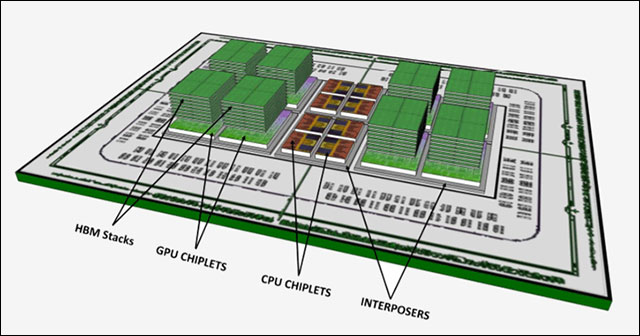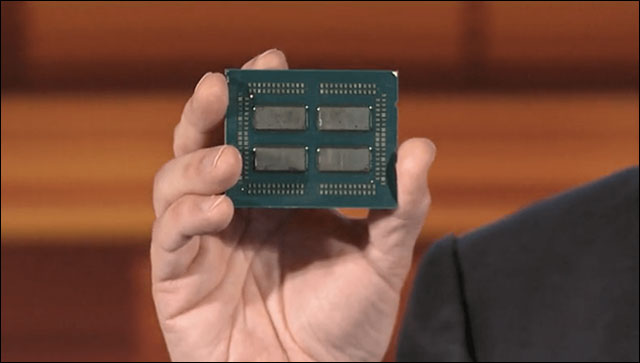Is chiplet the answer to Moore's law?
Moore's Law still says that the number of transistors will be halved each year. After that, every two years, there will be a change, but by 2016 Moore's law will slow down and new inventions are needed. Maybe chiplet is the answer.
Moore's Law has been the guiding principle for many years. But transistors cannot be smaller. The end has been seen in the near future and chip makers have to struggle to find new ways because that is what helped them sell chips for decades.
'Moore's Law is slowing down,' AMD's CRO Mark Papermaster told Wired. 'It is still possible to do a denser density but it will cost more and take more time.' So chip makers have to find a way to sell, creating more healthy chips to hit the market. After all, what do you buy a new device with a new processor if it isn't stronger than the old one?
A recent idea named chiplet is becoming hopeful. Understanding chiplet is the pieces of silicon that are stacked together like logo blocks. Instead of making a circuit board on a chip, the chipslets are 'jigsaw' in many different forms for multi-die multi-die processors for different tasks like machine learning or cloud computing. .

Constructing microprocessors in chiplet style
Both AMD and Intel believe the industry will go this way because it helps them quickly create more powerful processors. 'This is an evolution of Moore's law,' said Ramune Nagisetty, senior engineer at Intel. The current process of producing transistors and small chips is very complicated and expensive. The chiplet will provide a way to create a more powerful processor with less cost and less errors.
Chiplet is not something far away but has been tested by AMD when producing Epyc server processor. Epyc includes 4 chiplets and AMD engineers estimate that if they try to make it into a single big chip, at least the production cost will be double. Epyc's success was clear when earlier this week, AMD announced it would produce the second generation Epyc made from 8 chiplets (64 cores), doubling its power.

AMD's first generation Epyc server processor includes 4 chiplets
Intel is also working on the idea of modular design, creating processors for laptops that incorporate Intel CPUs with 'AMD-designed graphics modules'. This marks the first time Intel uses cores from other manufacturers to create its main processor.
'Chiplet-style matching helps parties work more closely than separate graphics processors,' Nagisetty said. The chip is currently used on HP and Dell products. Future chip generations are also ready.
The Pentagon is also interested in the new process, pledging to invest $ 1.5 billion through DARPA's Electronic Resurgence Initiative to study in this area. Universities, chip makers, contractors will receive funding through this program to develop chiplet technology. DARPA is also trying to create a new standard for modules from different vendors to work together. Intel has agreed to create a "free link technology" for its chiplet.
As this modular approach continues to evolve, we will wait and see how other components in the technology world will embrace the new architecture, and whether it can be an extended version of the Moore's law in the coming years.
See more:
- Intel's 9th generation chip shows a new path, no need to follow Moore's law
- Nvidia: Moore's Law is dead, the GPU will soon replace the CPU
- Can the computer grow stronger?
You should read it
- Vietnam has become a world smartphone factory
- TSMC postpones plans to test 3nm chips until October 2020
- Huawei recruited Nvidia employees, preparing to play with the company in GPU production?
- Intel's 9th generation chip shows a new path, no need to follow Moore's law
- Send military chip technology to China, an American professor at risk of 'peeling off' 219 years
- New molecular printing technology can reproduce a complex chemical environment similar to the human body
- Test your knowledge with P2 technology questions
- Top 8 best technology movies
May be interested
- 7 AI tools that answer questions directly from PDF files
 whether for study or work, going through long pdfs to find any particular piece of information is the most tedious thing to do. however, you can make things easier by using ai tools to answer questions from pdf files.
whether for study or work, going through long pdfs to find any particular piece of information is the most tedious thing to do. however, you can make things easier by using ai tools to answer questions from pdf files. - How to create Answer questions on Facebook
 creating question answers is a recently added feature on both facebook web and the app. users will choose questions and answer them themselves and post to facebook.
creating question answers is a recently added feature on both facebook web and the app. users will choose questions and answer them themselves and post to facebook. - How to circle answers in Word, Excel, PowerPoint
 to circle the answer in word, excel, powerpoint is very simple, you can use the symbol tool or draw a circle in the content you are editing.
to circle the answer in word, excel, powerpoint is very simple, you can use the symbol tool or draw a circle in the content you are editing. - How to enable auto-answer calls on iOS 11
 auto-answer calls on ios 11 is a feature that automatically receives incoming calls from your phone or other voip services such as whatsapp or skype if you are connected to the internet.
auto-answer calls on ios 11 is a feature that automatically receives incoming calls from your phone or other voip services such as whatsapp or skype if you are connected to the internet. - Test your talent: The magical crossword
 think and solve this magic crossword, the $ 100 prize will be for 10 members with the fastest and most accurate answer
think and solve this magic crossword, the $ 100 prize will be for 10 members with the fastest and most accurate answer - IQ puzzle or answer: Who stole the beach bracelet?
 the following test helps you train your brain including thinking ability, judgment and patience. only logical thinkers answer the right questions. if you do not answer correctly, you are a lazy person. let's start.
the following test helps you train your brain including thinking ability, judgment and patience. only logical thinkers answer the right questions. if you do not answer correctly, you are a lazy person. let's start. - 8 Sophisticated Ways Hackers Use to Steal Your Security Answers
 if you think your security questions are a reliable backup to your password, you might be in for a surprise. hackers have clever ways to figure out those answers, and it's often easier than you think.
if you think your security questions are a reliable backup to your password, you might be in for a surprise. hackers have clever ways to figure out those answers, and it's often easier than you think. - Answer – Should I use RAR or ZIP files?
 are you wondering whether to use rar or zip files? tips boss will immediately answer this problem so you can understand better!
are you wondering whether to use rar or zip files? tips boss will immediately answer this problem so you can understand better! - LAN test with answer - Part 2
 the lan question set has the answer.
the lan question set has the answer. - 15 questions interview the 'hottest' programmers and answer suggestions
 below is a set of developer interview questions that are often used and suggested by employers to invite you to refer to the best results in the interview.
below is a set of developer interview questions that are often used and suggested by employers to invite you to refer to the best results in the interview.










 Windows is not a service, it's just an operating system, don't update it too much like that!
Windows is not a service, it's just an operating system, don't update it too much like that! DNA information leaks are worse than leaking many credit card information
DNA information leaks are worse than leaking many credit card information How to keep Facebook server from collapsing?
How to keep Facebook server from collapsing? Never upgrade the operating system from the first day
Never upgrade the operating system from the first day 2018 smartphone market: Winners and losers
2018 smartphone market: Winners and losers Why are flagship smartphones more expensive?
Why are flagship smartphones more expensive?